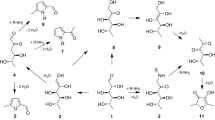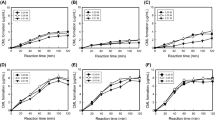Abstract
In the present study, the extent of the Maillard reaction in peanuts was investigated, using N-ε-fructosyllysine (ε-Fru-Lys, determined via furosine) as an indicator for the early stage, and pyrraline and N-ε-carboxymethyllysine (CML) as representatives for advanced glycation. In commercial samples, ε-Fru-Lys ranged between 1.5 and 13.3 mmol/mol lysine. Pyrraline was found in amounts between not detectable (below 0.3 mmol/mol lysine) and 9.0 mmol/mol lysine, and CML between 0.8 and 2.7 mmol/mol lysine. Lysine modification by glycation products was very low in cooked and fried peanuts (below 1%). In laboratory-scale roasting experiments, the amount of ε-Fru-Lys reached maximum values of 12.0 mmol/mol lysine after 20 min at 160 °C, whereas pyrraline increased up to 38.5 mmol/mol lysine after 25 min at 170 °C. Amount of CML was up to 1.8 mmol/mol lysine in peanuts roasted for 25 min at 170 °C. Such high amounts of pyrraline have not yet been described for any other food item. Only about one tenth of the totally observed lysine modification of up to 50% can be explained by the three glycation compounds, indicating that currently unknown reactions occur during peanut roasting. Reactions between proteins and carbonyl compounds, most likely originating from oxidative degradation of lipids, may play an important role for lysine derivatization in peanuts and should be analyzed more in detail.





Similar content being viewed by others
Abbreviations
- MRP:
-
Maillard reaction product
- AP:
-
Amadori product
- AGE:
-
Advanced glycation end product
- CML:
-
N-ε-carboxymethyllysine
- ε-Fru-Lys:
-
N-ε-fructosyllysine
References
Maguire LS, O’Sullivan SM, Galvin K, O’Connor TP, O’Brian NM (2004) Fatty acid profile, tocopherol, squalene and phytosterol content of walnuts, almonds, peanuts, hazelnuts and the macadamia nut. Int J Food Sci Nutr 55:171–178
Beyer K, Morrow E, Li X-M, Bardina L, Bannon GA, Burks W, Sampson HA (2001) Effects of cooking methods on peanut allergenicity. J Allergy Clin Immunol 107:1077–1081
Souci SW, Fachmann W, Kraut H (2000) Food composition and nutrition tables, 6th edn. Medpharm Scientific Publishers, Stuttgart
Vercellotti JR, Sanders TH, Chung S-Y, Bett KL, Vinyard BT (1995) Carbohydrate metabolism in peanuts during postharvest curing and maturation. Dev Food Sci 37:1547–1578
Maleki SJ, Chung S-Y, Champagne ET, Raufman J-P (2000) The effects of roasting on the allergenic properties of peanut proteins. J Allergy Clin Immunol 106:763–768
Chung S-Y, Champagne ET (2001) Association of end-product adducts with increased IgE binding of roasted peanuts. J Agric Food Chem 49:3911–3916
Henle T (2007) Dietary advanced glycation end products—a risk to human health? A call for an interdisciplinary debate. Mol Nutr Food Res 51:1075–1078
Erbersdobler HF, Somoza V (2007) Forty years of furosine—forty years of using Maillard reaction products as indicators of the nutritional quality of foods. Mol Nutr Food Res 51:423–430
Silván JM, van de Lagemaat J, Olano A, del Castillo MD (2006) Analysis of biological properties of amino acid derivatives formed by Maillard reaction in foods. J Pharm Biomed Anal 41:1543–1551
Bohle B, Zwölfer B, Heratizadeh A, Jahn-Schmid B, Antonia YD, Alter M, Keller W, Zuidmeer L, van Ree R, Werfel T, Ebner C (2006) Cooking birch pollen-related food: divergent consequences for IgE- and T cell-mediated reactivity in vitro and in vivo. J Allergy Clin Immunol 118:242–249
Burks WA, Williams LW, Thresher W, Connaughton C, Cockrell G, Helm RM (1992) Allergenicity of peanut and soybean extracts altered by chemical or thermal denaturation in patients with atopic dermatitis and positive food challenges. J Allergy Clin Immunol 90:889–897
Mondoulet L, Drumare M-F, Ah-Leung S, Paty E, Scheinmann P, Wal J-M, Bernard H (2003) Influence des procédés thermiques sur l’allergénicité de l’arachide. Rev Fr Allergol 43:486–491
Malanin K, Lundberg M, Johansson SGO (1995) Anaphylactic reaction caused by neoallergens in heated pecan nut. Allergy 50:988–991
Ilchmann A, Burgdorf S, Scheurer S, Waibler Z, Nagai R, Wellner A, Yamamoto Y, Yamamoto H, Henle T, Kurts C, Kalinke U, Vieths S, Toda M (2010) Glycation of a food allergen by the Maillard reaction enhances its T-cell immunogenicity: Role of macrophage scavenger receptor class A typ I and II. J Allergy Clin Immunol 125:175–183
Henle T, Bachmann A (1996) Synthesis of pyrraline reference material. Z Lebensm Unters Forsch 202:72–74
Delatour T, Fernaille F, Parisod V, Vera FA, Buetler T (2006) Synthesis, tandem MS- and NMR-based characterization, and quantification of the carbon 13-labeled advanced glycation endproduct, 6-N-carboxymethyllysine. Amino Acids 30:25–34
Resmini R, Pellegrino L, Batelle JW (1990) Accurate quantification of furosine in milk and dairy products by a direct HPLC method. Ital J Food Sci 3:173–183
Förster A, Kühne Y, Henle T (2005) Studies on absorption and elimination of dietary Maillard reaction products. Ann NY Acad Sci 1043:474–481
Dunn JA, McCance DR, Thorpe SR, Lyons TJ, Baynes JW (1991) Age-dependent accumulation of N ε-(carboxymethyl)lysine and N ε-(carboxymethyl)hydroxylysine in human skin collagen. Biochemistry 30:1205–1210
Wellner A, Huettl C, Henle T (2011) Formation of Maillard reaction products during heat treatment of carrots. J Agric Food Chem 59:7992–7998
Henle T, Walter H, Krause I, Klostermeyer J (1991) Efficient determination of individual Maillard compounds in heat-treated milk products by amino acid analysis. Int Dairy J 1:125–135
Krause R, Knoll K, Henle T (2003) Studies on the formation of furosine and pyridosine during acid hydrolysis of different Amadori products of lysine. Eur Food Res Technol 216:277–283
Henle T, Walter H, Klostermeyer H (1991) Evaluation of the extent of the early Maillard-reaction in milk products by direct measurement of the Amadori-product lactuloselysine. Z Lebensm Unters Forsch 193:119–122
Henle T, Walter AW, Klostermeyer H (1994) Simultaneous determination of protein-bound Maillard products by ion exchange chromatography and photodiode array detection. In: Maillard reactions in chemistry, food, and health. Royal Society of Chemistry, Cambridge, pp 194–200
Henle T, Zehetner G, Klostermeyer H (1995) Fast and sensitive determination of furosine. Z Lebensm Unters Forsch 200:235–237
Gardner HW (1979) Lipid hydroperoxide reactivity with proteins and amino acids: a review. J Agric Food Chem 27:220–229
Nielsen HK, Loliger J, Hurrell F (1985) Reaction of proteins with oxidizing lipids. 1. Analytical measurements of lipid oxidation and of amino acid losses in a whey protein-methyl lineolate model system. Br J Nutr 53:61–73
Friedman M (1996) Food browning and its prevention: an overview. J Agric Food Chem 44:631–653
Henle T, Walter AW, Klostermeyer H (1993) Detection and identification of the cross-linking amino acids N τ- and N π-(2′-amino-2′-carboxy-ethyl)-l-histidine (“histidinoalanine”, HAL) in heated milk products. Z Lebensm Unters Forsch 197:114–117
Walter AW, Henle T, Klostermeyer H (1994) Studies on the formation of lysinomethylalanine and histidinomethylalanine in milk products. Z Lebensm Unters Forsch 199:243–247
Acknowledgments
We thank Karla Schlosser for performing the amino acid analysis.
Author information
Authors and Affiliations
Corresponding author
Electronic supplementary material
Below is the link to the electronic supplementary material.
Rights and permissions
About this article
Cite this article
Wellner, A., Nußpickel, L. & Henle, T. Glycation compounds in peanuts. Eur Food Res Technol 234, 423–429 (2012). https://doi.org/10.1007/s00217-011-1649-8
Received:
Revised:
Accepted:
Published:
Issue Date:
DOI: https://doi.org/10.1007/s00217-011-1649-8




